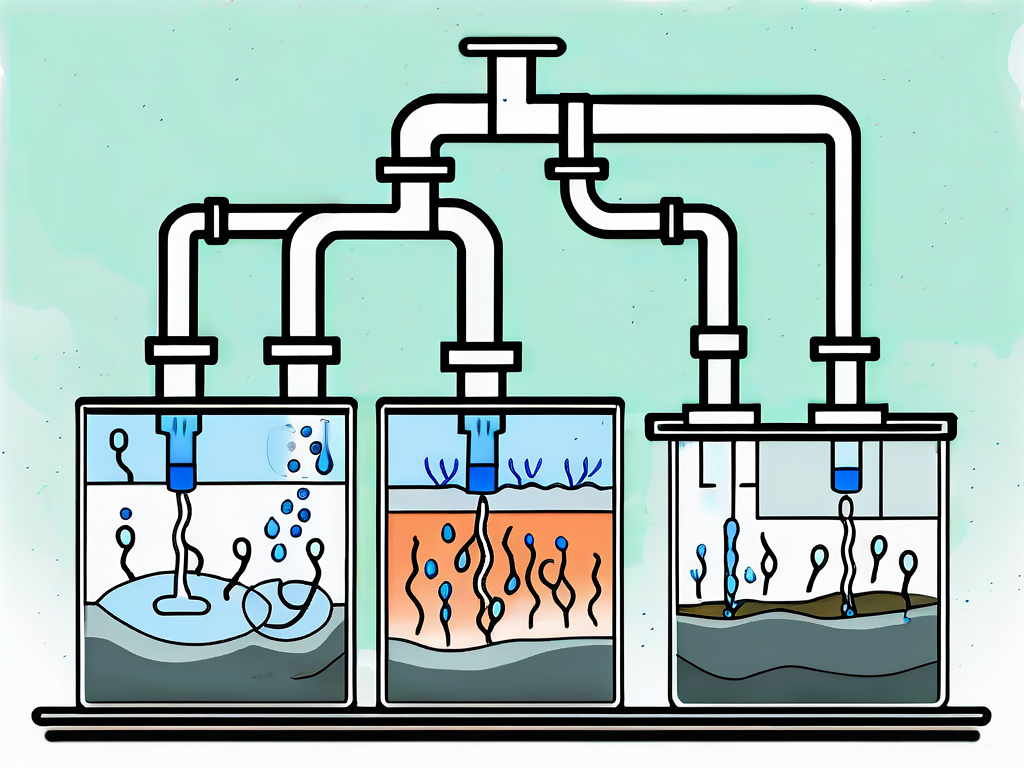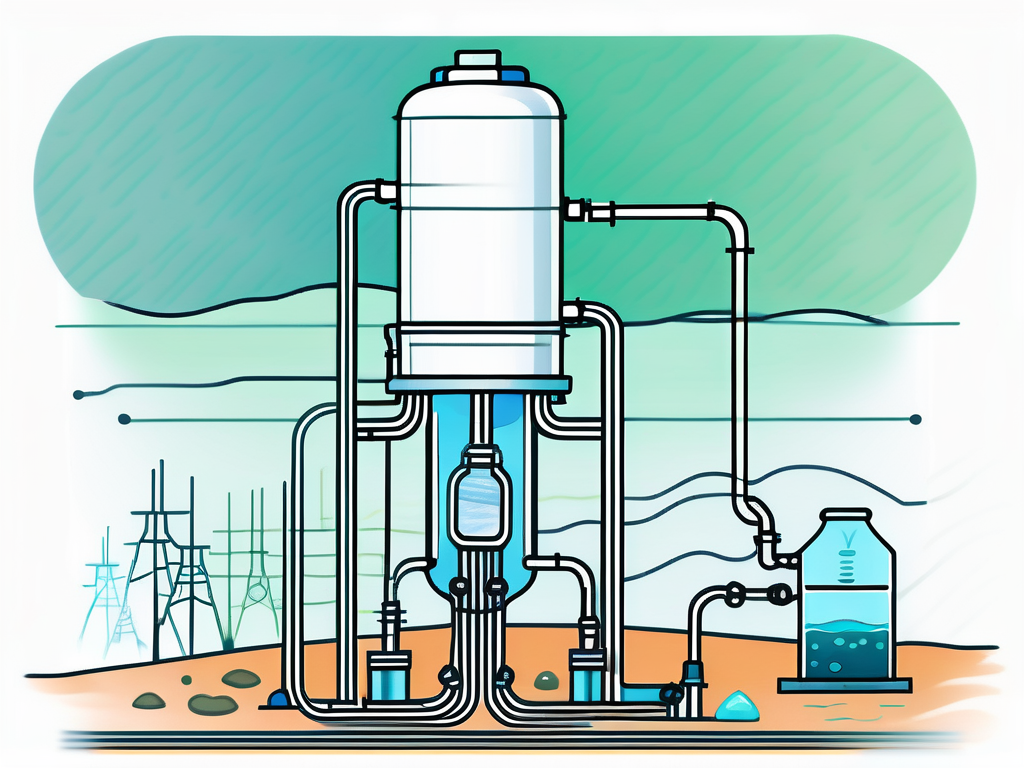
Microbial Fuel Cell: Wastewater Treatment Explained
In the realm of wastewater treatment, microbial fuel cells (MFCs) represent a promising technology that harnesses the power of microorganisms to convert chemical energy into electrical energy. This innovative approach not only purifies wastewater but also generates electricity in the process, making it a sustainable solution for wastewater management.
Understanding the intricacies of microbial fuel cells and their role in wastewater treatment requires delving into the realms of microbiology, chemistry, and environmental science. This glossary entry aims to provide a comprehensive understanding of the topic, breaking down complex concepts into digestible sections.
Principles of Microbial Fuel Cells
The fundamental principle behind MFCs is the ability of certain bacteria to transfer electrons to an external surface during their metabolic process. These bacteria, known as exoelectrogens, can oxidize organic matter in wastewater, producing electrons and protons. The electrons are transferred to the anode, creating an electric current, while the protons migrate to the cathode through a proton exchange membrane.

The cathode, exposed to oxygen, combines the incoming electrons and protons with oxygen to form water. This process of electron transfer from the anode to the cathode through an external circuit is what generates electricity in a microbial fuel cell.
Exoelectrogens
Exoelectrogens are a special type of bacteria that can transfer electrons to an external surface, such as the anode of a microbial fuel cell. These bacteria are the driving force behind the electricity generation in MFCs. They oxidize organic matter in the wastewater, releasing electrons and protons in the process.
The ability of exoelectrogens to transfer electrons externally differentiates them from other bacteria that transfer electrons internally to terminal electron acceptors. The study of these bacteria and their electron transfer mechanisms is a key area of research in the development of MFC technology.
Proton Exchange Membrane
The proton exchange membrane (PEM) is a crucial component of a microbial fuel cell. This membrane allows protons produced at the anode to migrate to the cathode, while preventing the direct mixing of the anode and cathode solutions. The PEM is typically made from a material that is selectively permeable to protons and impermeable to electrons.
The choice of PEM material can significantly impact the performance of a microbial fuel cell. Ideal PEM materials should have high proton conductivity, low electron conductivity, and good chemical stability. They should also be affordable and readily available for practical applications of MFC technology.
Design and Construction of Microbial Fuel Cells
The design and construction of MFCs can vary widely depending on the specific application and performance requirements. However, all MFCs share some basic components: an anode, a cathode, a proton exchange membrane, and an external circuit. The anode and cathode compartments are often separated by the PEM to prevent the direct mixing of their solutions.
The anode is where the exoelectrogens reside and oxidize the organic matter in the wastewater. The cathode is exposed to oxygen and combines the incoming electrons and protons to form water. The external circuit connects the anode and cathode, allowing the flow of electrons and generating an electric current.
Anode and Cathode Materials
The choice of anode and cathode materials is a critical factor in the performance of a microbial fuel cell. The anode material should provide a suitable surface for the attachment and growth of exoelectrogens, and facilitate efficient electron transfer. Commonly used anode materials include carbon-based materials such as graphite and carbon cloth.
The cathode material should facilitate the reduction of oxygen to water. It is often coated with a catalyst to enhance this reaction. Platinum is a commonly used catalyst, but due to its high cost, research is ongoing to find more affordable alternatives.
External Circuit
The external circuit of a microbial fuel cell connects the anode and cathode, allowing the flow of electrons from the anode to the cathode. This flow of electrons is what generates the electric current in the MFC. The external circuit often includes a resistor or a load to control the current flow and measure the power output of the MFC.
The design of the external circuit can significantly impact the performance of a microbial fuel cell. For instance, the choice of wire material and thickness can affect the resistance and hence the power output of the MFC. Similarly, the placement and design of the load or resistor can influence the efficiency of the MFC.
Applications of Microbial Fuel Cells in Wastewater Treatment
Microbial fuel cells offer a sustainable solution for wastewater treatment, with the added benefit of electricity generation. By harnessing the metabolic activities of exoelectrogens, MFCs can effectively degrade organic pollutants in wastewater, improving its quality and reducing its environmental impact.
Moreover, the electricity generated by MFCs can be used to power small devices or contribute to the energy needs of the wastewater treatment plant, further enhancing the sustainability of the process. The potential applications of MFCs in wastewater treatment are vast and continue to expand with ongoing research and development.
Organic Pollutant Degradation
One of the primary applications of microbial fuel cells in wastewater treatment is the degradation of organic pollutants. Exoelectrogens can oxidize a wide range of organic compounds, converting them into carbon dioxide, water, and electricity. This process can significantly reduce the biochemical oxygen demand (BOD) and chemical oxygen demand (COD) of the wastewater, two key indicators of organic pollution.
Moreover, the degradation of organic pollutants by MFCs is a relatively slow process, which allows for the complete mineralization of the pollutants. This is in contrast to conventional wastewater treatment processes, which often result in the partial degradation of pollutants and the production of harmful byproducts.
Electricity Generation
While the primary purpose of microbial fuel cells in wastewater treatment is the degradation of organic pollutants, the electricity generation is a valuable byproduct of the process. The electricity produced by MFCs can be used to power small devices, such as sensors and monitors, in the wastewater treatment plant. This can reduce the energy consumption of the plant and contribute to its sustainability.
Furthermore, with advancements in MFC technology and scale-up, the electricity generated by MFCs could potentially contribute to the grid, further enhancing the environmental benefits of this technology. However, this application is still in its early stages and requires further research and development.
Challenges and Future Directions in Microbial Fuel Cell Technology
Despite the promising potential of microbial fuel cells in wastewater treatment and electricity generation, several challenges need to be addressed to realize their full potential. These challenges include the low power output of MFCs, the high cost of materials, and the complexity of scaling up the technology.

Moreover, the performance of MFCs can be influenced by a wide range of factors, including the type and concentration of organic matter in the wastewater, the characteristics of the exoelectrogens, and the design and operation of the MFC. Understanding and optimizing these factors is a key area of research in MFC technology.
Improving Power Output
The power output of microbial fuel cells is currently relatively low compared to other renewable energy technologies. This is partly due to the slow rate of organic matter oxidation by exoelectrogens, and the losses in the electron transfer process. Research is ongoing to improve the power output of MFCs, through the optimization of MFC design and operation, and the enhancement of exoelectrogen activity.
For instance, the use of biofilm-promoting anode materials can enhance the attachment and growth of exoelectrogens, improving the rate of organic matter oxidation. Similarly, the use of more efficient proton exchange membranes and catalysts can reduce the losses in the electron transfer process and enhance the power output.
Reducing Material Costs
The high cost of materials, particularly the proton exchange membrane and the cathode catalyst, is a major barrier to the widespread adoption of microbial fuel cell technology. Research is ongoing to find more affordable alternatives to these materials, without compromising the performance of the MFC.
For instance, the use of non-precious metal catalysts or bio-catalysts at the cathode can reduce the cost of the catalyst. Similarly, the use of low-cost materials for the proton exchange membrane, such as sulfonated polymers, can reduce the cost of the PEM. However, these alternatives need to be evaluated for their long-term stability and performance in MFCs.
Scaling Up MFC Technology
Scaling up microbial fuel cell technology from the laboratory to the field is a complex process that requires careful consideration of various factors. These include the design and construction of large-scale MFCs, the management of exoelectrogen communities, and the integration of MFCs into existing wastewater treatment processes.
Research is ongoing to address these challenges and develop practical guidelines for the scale-up of MFC technology. For instance, the use of modular MFC designs can facilitate the scale-up process and allow for flexibility in operation. Similarly, the use of robust and diverse exoelectrogen communities can enhance the stability and performance of large-scale MFCs.
Conclusion
Microbial fuel cells represent a promising technology for wastewater treatment and electricity generation. By harnessing the power of exoelectrogens, MFCs can effectively degrade organic pollutants in wastewater and generate electricity in the process. However, several challenges need to be addressed to realize the full potential of this technology, including improving the power output, reducing material costs, and scaling up the technology.
With ongoing research and development, microbial fuel cells could become a key player in the future of wastewater treatment, contributing to the sustainability of the process and the generation of renewable energy. As such, understanding the principles, applications, and challenges of MFC technology is crucial for anyone interested in the field of wastewater treatment.



